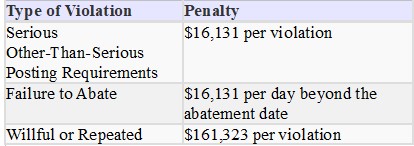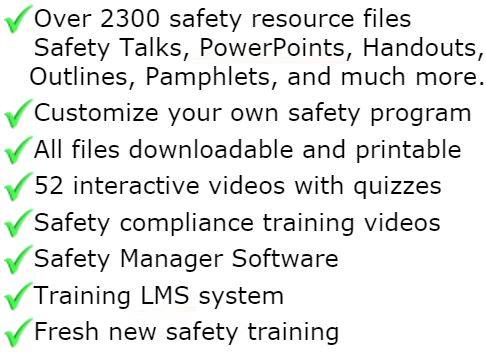
Safety Signs & Labels
Use of safety signs, labels and tags to visually convey hazard information to employees is required by 29CFR 1910.145 and other OSHA standards such as those for hazard communication, egress, confined space and Bloodborne Pathogens. OSHA standard 1910.145 covers the design, application and use of signs or symbols to identify specific hazards that could lead to injury, illness or property damage. OSHA has incorporated, by reference, the American National Standard Z53.1-1967 for specific sign color, size, lettering and contrast.
Information Safety Signs
Beyond the typical "Notice" signs, there is sometimes the need for more detailed information signs that provide complex instructions. Generally, these are in the form of Posted Operating Instructions for equipment or processes that require specific step-by-step procedures to ensure safe operation. Plastic laminated paper instruction can be used in areas that are clean and dry, however, photoengraved metal signs will last longer, especially in areas that have wet or dirty operations.
Exit Signs
OSHA requires that Exits be marked by a readily visible sign with plainly legible letters not less than 6 inches high and illuminated on the surface to at least a value of 5 foot-candles. Most "glow in the dark" signs do not meet this lighting requirement. Access to exits must also be marked by signs showing the direction (arrows) of the exit or way to reach it. Additionally, any door, passage, or stairway which is neither an exit nor a way of exit access, and which may be mistaken for an exit, must be identified by a sign reading "Not an Exit" or by a sign indicating its actual use, such as "To Basement," "Storeroom," "Linen Closet," or the like.
Chemical Safety Hazards
In the workplace, OSHA’s Hazard Communication Standard requires that each container of hazardous chemicals is labeled, tagged or marked. The identity of the hazardous chemical and appropriate hazard warnings, words, pictures, symbols must provide at least general information regarding the hazards of the chemical. Signs, placards, process sheets, batch tickets, operating procedures, or other written materials may be substituted for labels on individual stationary process containers, as long as this method identifies the containers to which it is applies and provides the same information required on labels. Small, portable containers, intended only for the immediate use of an employee and not for storage, do not require labels. Existing labels on containers, provided by the manufacturer, may not be removed or defaced unless the container is immediately marked with the required information.
Employee protection in public work areas
Before work is begun in the vicinity of vehicular or pedestrian traffic which may endanger employees, warning signs and/or flags or other traffic control devices must be placed conspicuously to alert and channel approaching traffic. At night, warning lights must be prominently displayed.
Safety Signs
Employers are required to conduct training to ensure workers understand the various types and meanings of signs in their facilities. The best time to train is during new hire safety orientation and during annual safety refreshers. Showing and explaining safety signs and their meanings in company newsletter and on employee bulletin boards will also help improve employees’ awareness of hazard signs. Effective employee training includes showing every type of sign, tag and label used. You should also provide an explanation of each purpose, meaning and what you expect employees to do when they encounter specific signs, labels or tags. Take special care to fully show and explain your hazard communication - chemical safety labeling program, which is also required by OSHA.
Sign Placement
Place hazard signs as close to the hazard as possible to create a definite link between the message and the hazard. Placing a group of hazard signs on a door, entryway or wall is asking for confusion. Let’s take a look at a typical plant maintenance shop. Every bench mounted tool should have hazard signs posted that require the use of eye protection and any other operation hazard that is applicable to the specific tool. These signs should be placed so that they are highly visible to the tool operator.
How you treat your signs sends a message. Over time signs become faded, damaged and totally useless for the intended hazard message. Outdated, faded or damaged signs send a negative message about your emphasis on safety. To show employees that the hazard sign messages are important, replace them (the signs not the employees) as soon as they have any wear or damage. Have replacement signs available - stock enough replacement signs so there is no wait when a sign needs to be replaced.
Sign Language Barrier
Being able to employ a diverse language workforce is essential in some industries. Using pictogram type safety signs to convey a hazard message can break reading or language barriers. To ensure that non-English speaking employees understand, some companies are employing translators to accompany trainers on facility tours with new employees to explain specific signs and their meanings. The food industry, which employees many non-English speaking Hispanic workers has seen the importance of bilingual signs. While bilingual signs are helpful, experience has shown that, as an example, not all "Hispanic" peoples speak or read the Spanish language the same - many words have entirely different meanings to various groups of peoples classified as "Hispanic". The same is true for many other ethnic groups.
Temporary Safety Signs
Certain operations may require the use of temporary visual warning. One of the most familiar is the "wet floor" sign placed by custodians. Others include those placed at boundaries of electrical work areas, confined space entry operations, temporary containment for asbestos removal or chemical spill cleanup. OSHA also requires that if work exposes energized or moving parts that are normally protected, danger signs must be displayed and barricades erected, to warn other people in the area.
All materials in the members area for this topic index

GET INSTANT ACCESS
to THE MEMBERS LIBRARY
Safety materials created by safety professionals.
Access to the Safety Manager software.
Wide variety of safety videos and courses.
**Brand New** Safety Training Management System
Pre-Made Safety Materials Ready For Use
Created by experienced safety professionals & risk consultants. Saving you time, money, and risk of injuries.
95% of the work already done.
Below are the maximum penalty amounts, with the annual adjustment for inflation, that may be assessed after Jan. 15, 2024. (See OSHA Memo, Jan. 8, 2024).

**New OSHA HEAT 90 DAY**
>>Download Free HERE<<
**New 2024 OSHA 300 Form**
>>Download Free HERE<<
**Brand New**
Free with full membership subscription
Training LMS System
Ask The Safety Consultant
Safety Equipment Deal Finder

“SafetyInfo.com is the first go-to website for safety professionals and companies to use in establishing a solid safety program"
-Mike McKenzie, Certified Safety & Health Manager (CSHM), McSafety Solutions™
Note: You must have a full subscription to the Safety Library in order to use this material. Any use outside of your organization, for resell, or without an active membership is strictly prohibited and may result in prosecution under copyright infringement laws. Please contact us first, if you would be interested in reselling or using our materials for reproduction.
Inside the Members Library
Topic Index
Accident Prevention
Air Quality
Asbestos
Bloodborne Pathogens
Boilers
Chemical Safety
Compressed Gas
Confined Space
Construction
Construction Worksite
Cranes & Slings
Driver / Fleet Safety
Drug Free Workplace
Electrical
Emergency Management
Engineering Safety
Environmental
Equipment
Ergonomics
Fall Protection
Fire Safety & Prevention
First Aid
Flammable Materials
Forklifts
Hazard Communication
Hazardous Materials
Hearing Protection
Heat Stress
Hot Work
Housekeeping
Job Safety Analysis
Laboratory
Ladders
Lead
Lockout-Tagout
Machinery & Equipment
Material Handling
MSDS (SDS)
Medical & First Aid
Occupational Health
Office Safety
Off the Job Safety
Personal Protection
Process Safety
Record Keeping
Respiratory Protection
Silica Safety
Rules & Policies
Signs & Labels
Slips, Trips & Fall
Training
Terrorism Programs
Tool Safety
Vehicle & Driver
Violence Programs
Welding & Hot Work
Training Videos
Library Index
Training Materials
Videos/Courses
Talks
Articles
PowerPoint
Handouts
Training Overheads
Quizzes
Supervisor Briefs
Management Briefs
Safety Sessions
2 Minute OSHA Safety Talks
Pamphlets
First Aid Training
Supervisor Training
Hazardous Materials
Bomb Threat
Crossword Puzzles
Biological Agents
Forms & Documents
Forms
Checklists
Audit Guides
Inspections Guides
Signs & Labels
Environmental Audit Guides
Recordkeeping - OSHA 300
Sign & Label Maker
Safety Management Resources
Safety Manuals/Written Programs
Ergonomic Programs
Emergency Plans
Process Safety Management
Construction Safety
Occupational Health
Environmental
Topic Sheets
DOT Fleet-Driver
Hazardous Materials
Chemical Safety
Drug Free Workplace
Terrorism Programs
Development Guides
Safety Manager Software
Safety References & Graphics
Technical Safety Information
Posters
Topic & Fact Sheets
Development Information
Job Specific Safety Rules
Terrorism
Calculators
Safety Comic Strips
New Safety Training System
Schedule and train your employees with our materials. Add unlimited amount of employees. Record all progress and issue certificates. For group and individual training sessions.

